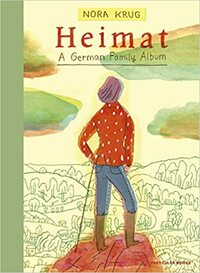Take a photo of a barcode or cover
Belonging or "Heimat" in German is a mix of a graphic novel and historical research text. It follows the author researching her German genealogy pre and post Second World War. The guilt of 20th-century fascism and the search for redemption are some of the main themes. Surprisingly, the book is very interesting to read and lighthearted in art style. Therefore, it comes in contrast with the tragic stories that Nora Krug narrates and somehow humanizes them.
Belonging: A German Reckons with History and Home is a powerful memoir by Nora Krug that is captivating both verbally and visually.
Nora Krug grew up in Germany and discusses what it was like learning about WWII and their country's atrocities. When in school, nothing was sugarcoated and there was a sense of collective guilt. Her parents were born after World War II, but the more she learned, the more curious she became as to the involvement of her grandparents and other relatives.
When she moved to the United States, her interest only grew; she wasn't proud of being a German and would try to hide her accent because of the reactions of others when they found out where she was from. But as she began to long for home, she wanted to dig into the family stories.
Heimat is a German word introduced early and returned to often, which refers to a place where you have familiarity, where you feel connected, where you belong.
"Perhaps the only way to find the HEIMAT that I've lost is to look back; to move beyond the abstract shame and ask those questions that are really difficult to ask -- about my own hometown, about my father's and my mother's families. To make my way back to the towns where each of them is from. To return to my childhood, go back to the beginning, follow the bread crumbs, and hope they'll lead the way home." (page 54)
So begins Krug's return to Germany as she visits where her grandparents lived during the war, searching the archives, conducting interviews, and unearthing the truth. It's an engaging book that is an important read as we all weigh how events throughout history and our family's involvement in them shape us.
I was intrigued by how the graphic novel format would convey the information, and I was suitably impressed. I've been reading books on drawing techniques and artistic journaling, and this book was a feast for the eyes. Nora Krug is a skilled artist and I felt as if I was reading someone's personal accounts in their journal, illustrated with all the care you see in adept bullet journal aficionados (let that comparison not take away Nora Krug's skill -- she is talented, and I also follow some bujo artists, so the connection is meant to be a fine compliment). The use of photos, sketches, dried flowers, even images of medals and wood carvings, make this a rich tribute.
I experienced this in a digital form, and while it was a rich, beautiful work, I highly recommend, if possible, you read a physical copy. Some of the background images span two pages, so it's a richer experience if you can see it spread before you.
(I received a digital ARC from NetGalley and Scribner in exchange for my honest review.)
Nora Krug grew up in Germany and discusses what it was like learning about WWII and their country's atrocities. When in school, nothing was sugarcoated and there was a sense of collective guilt. Her parents were born after World War II, but the more she learned, the more curious she became as to the involvement of her grandparents and other relatives.
When she moved to the United States, her interest only grew; she wasn't proud of being a German and would try to hide her accent because of the reactions of others when they found out where she was from. But as she began to long for home, she wanted to dig into the family stories.
Heimat is a German word introduced early and returned to often, which refers to a place where you have familiarity, where you feel connected, where you belong.
"Perhaps the only way to find the HEIMAT that I've lost is to look back; to move beyond the abstract shame and ask those questions that are really difficult to ask -- about my own hometown, about my father's and my mother's families. To make my way back to the towns where each of them is from. To return to my childhood, go back to the beginning, follow the bread crumbs, and hope they'll lead the way home." (page 54)
So begins Krug's return to Germany as she visits where her grandparents lived during the war, searching the archives, conducting interviews, and unearthing the truth. It's an engaging book that is an important read as we all weigh how events throughout history and our family's involvement in them shape us.
I was intrigued by how the graphic novel format would convey the information, and I was suitably impressed. I've been reading books on drawing techniques and artistic journaling, and this book was a feast for the eyes. Nora Krug is a skilled artist and I felt as if I was reading someone's personal accounts in their journal, illustrated with all the care you see in adept bullet journal aficionados (let that comparison not take away Nora Krug's skill -- she is talented, and I also follow some bujo artists, so the connection is meant to be a fine compliment). The use of photos, sketches, dried flowers, even images of medals and wood carvings, make this a rich tribute.
I experienced this in a digital form, and while it was a rich, beautiful work, I highly recommend, if possible, you read a physical copy. Some of the background images span two pages, so it's a richer experience if you can see it spread before you.
(I received a digital ARC from NetGalley and Scribner in exchange for my honest review.)
Very moving book. It really makes me regret not talking to my grandparents and getting their stories when I still had the chance.
A beautiful foray into the past of not only one woman's family, but of an entire nation. Krug not only walks a fine line between being drawn to ones history, to seek out the answers within it, and glorifying the past, she demonstrates how it is best done. Written with honesty and compassion, this book reflects the difficulty many in the modern age face when looking at their history: can we be thankful for those who came before us, without whom we wouldn't exist, while simultaneously being critical of the atrocities many may have committed, or at least were complicit in? As Krug shows in her book, the answers to those questions aren't easily faced, much less actively sought.
I feel that this book would be right at home within library collections for any age group, as well as English classes. History classes would also be more than appropriate for this book, particularly early in the curriculum as learners are encouraged to face the harsh truths that history often presents us with.
I feel that this book would be right at home within library collections for any age group, as well as English classes. History classes would also be more than appropriate for this book, particularly early in the curriculum as learners are encouraged to face the harsh truths that history often presents us with.
It took awhile to get into, but this graphic memoir-style dive into history picked up the last 30%. I have never read a graphic novel of this style, with historical documents and family artifacts integrated into the storytelling.
This was a such a well written and thought-provoking examination of history, family and identity. Think Priestdaddy meets Maus.
Loved this! A great look at a German woman’s journey in the search of her identity while also uncovering the truth about her grandparents lives during Nazi Germany. I appreciate the great deal of research that went into this.
Belonging was a narrative of the author's ancestry told by using non-traditional pieces of history.
I've truly never read a book formatted like this before. Not only was it entirely handwritten, it featured German schoolwork, old photographs, the author's illustrations, and more. It feels as-if I just read through a private scrapbook.
This story was not only unique in the way it was told but in the message it was conveying. As an American, I have never stopped to think about the shame Germans carry due to the Holocaust or the loss of each family's history. I found this to be both informational, interesting, and thought-provoking.
My major issue with this book was how scattered it often felt and the lack of a family tree. We had to keep track of A LOT of people and the relationships got very tangled. Nevertheless, piecing together ones life by other accounts was strangely fascinating and I recommend this to anyone interested in that point in time.
Thank you to the publishers who provided me with an ARC of this book through NetGalley!
I've truly never read a book formatted like this before. Not only was it entirely handwritten, it featured German schoolwork, old photographs, the author's illustrations, and more. It feels as-if I just read through a private scrapbook.
This story was not only unique in the way it was told but in the message it was conveying. As an American, I have never stopped to think about the shame Germans carry due to the Holocaust or the loss of each family's history. I found this to be both informational, interesting, and thought-provoking.
My major issue with this book was how scattered it often felt and the lack of a family tree. We had to keep track of A LOT of people and the relationships got very tangled. Nevertheless, piecing together ones life by other accounts was strangely fascinating and I recommend this to anyone interested in that point in time.
Thank you to the publishers who provided me with an ARC of this book through NetGalley!
4.5 for me
I really enjoyed this graphic novel/memoir as it explored a family member trying to understand her German family's history and connection to Nazi Germany while most of her surviving family is reluctant
I really enjoyed this graphic novel/memoir as it explored a family member trying to understand her German family's history and connection to Nazi Germany while most of her surviving family is reluctant





